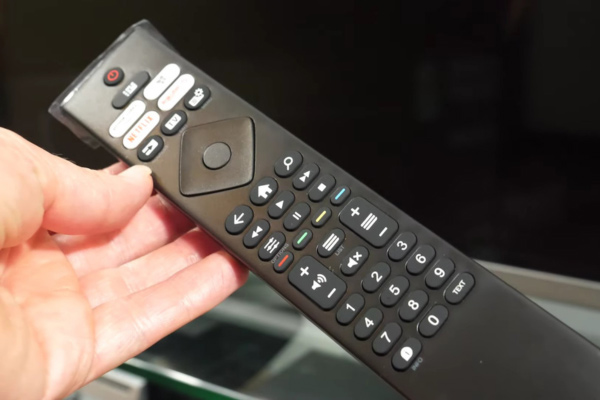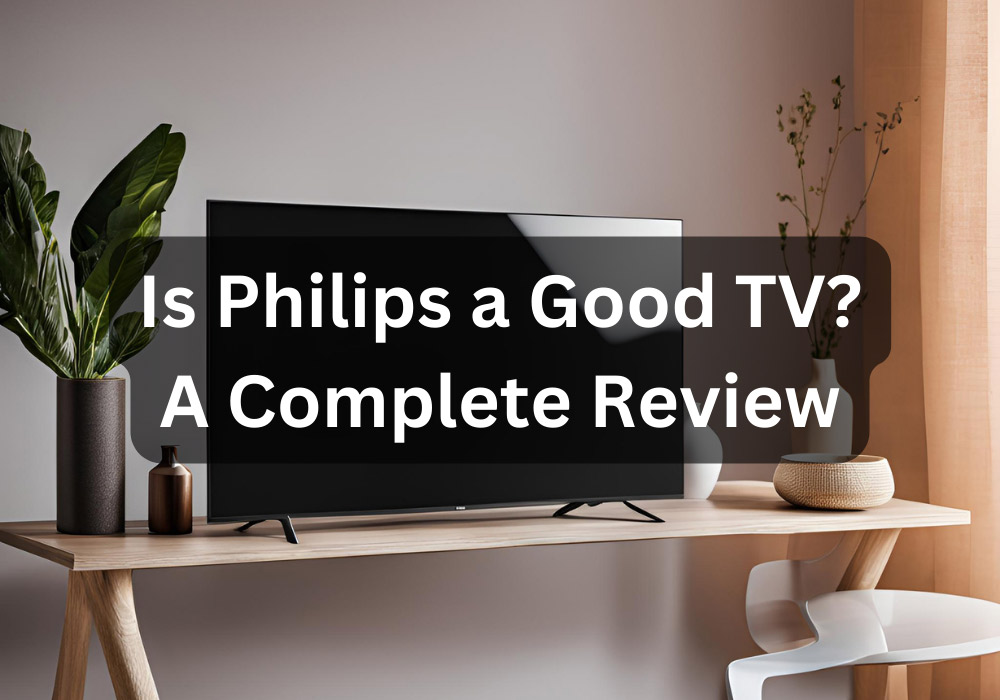You might be wondering, “Is Philips a good TV?” This is a question I’ve asked myself many times, especially because their price range seems so appealing given the features they offer. I’ve written this Philips TV review considering factors like picture and sound quality, user experience, and build quality to help you decide if their TVs are right for you.
Is Philips a Good Brand of TV? (Quick Answer)
I’ve personally reviewed a notable Philips TV (43PUS7608). In the picture below and the text that follows, you can see the results of my testing:

What Are the Advantages of Philips TVs?
- Affordable Pricing
- Good Picture Quality: Supports HDR10 and HLG formats, and provides decent color accuracy.
- User-friendly Interface: The Philips Smart TV Platform is easy to use and navigate, including most popular streaming services like Netflix, Prime Video, and YouTube.
- Wide Viewing Angles: Thanks to its IPS panel, the picture maintains its clarity at any viewing angle.
What Are the Disadvantages of Philips TVs?
- Mixed Reports about Long-Term Reliability: Some people who have bought and used a Philips TV for a year have reported screen flickering and slow response time issues.
- Limited Sound Quality: As is true for most TV speakers, the speakers on this device can’t provide an immersive experience and require an external sound setup.
- Bulkier Design: In today’s modern world, you expect thin TVs, but this Philips TV’s back panel is quite bulky and thick.
- Some Popular Apps Are Missing: HBO Max and Disney Plus aren’t included, which may be a drawback for their fans.
Understanding Philips TV Lineup
The Evolution of Philips TVs
Philips isn’t a newcomer in the world of TVs. They’ve come a long way and were among the earliest brands to introduce flat-screen TVs to the mass market. One of their most recognized features is Ambilight, which creates a mesmerizing effect with LED lights around the edges of the TV.
Their journey from early CRTs to LED, OLED, and even QLED displays suggests they’re constantly trying to cater to customers’ needs. I was encouraged to review one of their recent smart TV models, the Philips 43PUS7608. We’ll dive into the details of this TV in the upcoming sections.
Why are Philips TVs So Cheap?
Philips’ strategy is the reason behind their surprisingly low-priced TVs. They focus on offering solid mid-range models to the market, not flagships, and aren’t aiming to compete with the high-end models from LG, Sony, or Samsung.
They equip their moderately priced models with premium features like Dolby Atmos and Dolby Vision to make them appealing to users who want a quality TV without breaking the bank. Philips prioritizes models that appeal to the average user while cutting down on unnecessary extras that would increase the price.
Complaints From My Customers Over the Years
While Philips TVs offer excellent value for money initially, experience has shown that they’re not without issues. From my experience, some customers who seek consultation for their smart homes inform me that their Philips TV has had flickering issues, software bugs, or slow response times not long after purchase.
Additionally, some people suggest that the customer service hasn’t been very helpful. While these aren’t universal experiences and not all feedback is negative, I felt it’s important to mention these issues as they can affect the long-term reliability of Philips TVs.
Although Philips TVs appear to be a steal at first, they come with their own set of eccentricities. Numerous users soon report flickering displays, capricious software, and languid responsiveness
Philips TV Review: My Experience with the Philips 43PUS7608

Picture Quality
Wide Viewing Angles
Thanks to its IPS panel, you don’t need to worry about the viewing angles; the picture’s clarity is as clear as when sitting in front of the TV. This feature is a must in any home theatre setup, and fortunately, Philips TV succeeds in delivering it.
Contrast and Black Levels
While IPS panels are great with viewing angles, they’re not so satisfying at delivering true black levels. While watching a movie like Batman Begins by Christopher Nolan, you can see that the contrast in dark scenes isn’t as quiet as it is on VA or OLED panels, making the experience less immersive.
HDR Performance
HDR performance is a mixed bag. Yes, it supports HDR10 and HLG, but the hardware to fully realize the potential of these formats isn’t there. Brightness isn’t awful; I can say that the overall brightness is “OK”; the colour gamut is limited compared to what you’d get from a more pricey TV. However, I was impressed with how well TV can preserve the details in bright scenes; even in highly bright moments, the TV didn’t disappoint. Despite being a subtle touch, the performance makes you realize the difference when watching content with much contrast.
Motion Handling
The TV supports a 60 Hz refresh rate, meaning that it’s not the best option for pro gamers or those who watch action movies with a lot of fast-paced films, but for regular TV watching, it’s OK. I can say that the motion handling is average.
Sound Quality
The TV has two down-facing speakers, meaning that the sound is directed towards the surface it’s sitting on. This placement is standard for most TVs. However, just like any other TV, you shouldn’t anticipate anything special from the speakers of Philips 43PUS7608. They’re OK for everyday listening but won’t blow you away.
Speakers deliver dialogues clearly, making them great for watching news, talk shows, dramas, and any content where speech is mostly important. On the other hand, those willing to listen to music or action scenes with a lot of bass aren’t impressed at all. There are signs of bass, but not as deep as you get with a dedicated sound system, like a soundbar. The speakers handle high notes well, but they get a bit tinny as you increase the volume.
In total, I can say the speakers are good for casual TV watching, but for listening to music, playing games, watching action movies, and any other activity you want to get immersive audio, don’t get your expectations high.
The fact that this TV supports HDMI eARC promises that you can easily connect a modern, advanced sound system to it and enjoy immersive audio formats like Dolby Atmos.

User Experience and Interface
At first, I didn’t expect much from this TV’s interface since the older Philips TVs were all disappointed in the user experience. The interface used to be slow and clunky, which was a total pain in the neck!
On the other hand, I was impressed when I started working with this model. It runs on the Philips Smart TV platform, a custom system developed by Zeasn. The interface is clean and responsive, and it’s pretty user-friendly, even for those who aren’t tech-savvy. Navigating through menus is smooth, and apps load without noticeable delay.
The home screen is great; it includes the apps you use to provide you fast access to them. Plus, you can find many popular apps like Netflix, YouTube, and Prime Video, although it’s worth noting that the TV doesn’t have HBO Max and Disney Plus, which can be a drawback for their fans. So, the apps cover most bases, but it won’t be satisfying for HBO and Disney lovers.
The remote control can get the job done while not being the most professional and feature-full remote. It’s pretty easy to use; it features two buttons for Netflix and Prime Video streaming services. It is convenient when you want to jump straight to these platforms. Although I found the buttons at the bottom of the remote to be very small and cramped, they were hard to press!

Overall, the user experience was an area in which Philips 43PUS7608 got a good score; the whole process of the smart TV setup and going through the interface was straightforward.

Durability and Build Quality
Design and Materials
The overall design of this TV is standard; it is a fair combination of metal and plastic. The front looks sleek; it has thin side bezels and a thicker gray plastic bezel at the bottom. The anthracite feet look elegant but don’t add much flair to the TV look. I was disappointed in the TV’s back; it looks bulkier than modern designs and doesn’t look very good when mounted on the wall.
Construction Quality & Long-term Reliability
When assessing the quality of construction, I didn’t see anything odd that suggested low quality. The materials that Philips has used on the device feel solid. Still, they don’t provide the same quality as materials used in high-end TVs.
I’ve tested this TV for weeks and haven’t seen anything special to report in terms of the durability of its parts. However, as I mentioned earlier, not in this TV but in older models, people have reported issues of flickering screens and slow responses after a year of usage, which may be an overall concern for Philips TVs when it comes to their reliability after long use.
Conclusion
I hope this Philips TV review has helped you answer the question, “Is Philips a Good TV?” Based on my experience, Philips offers good TVs at a reasonable price. However, some users have indeed reported inconsistent performance from Philips TVs. In the end, I suggest you consider the amount of money you’re willing to spend and how much time you want the device to work for you; the answer to these questions can help you.
FAQs
Which is Better, LG or Philips TV?
Definitely LG. LG is a leader in the development of smart TVs. Its TVs are always the ones that have the latest technology in picture quality and smart features. LG’s OLED models are particularly outstanding. However, Philips can be a more budget-friendly choice, especially because of its advanced features (like Dolby Atmos) at such low prices. By comparison, LG definitely wins.
Do Philips TVs Last?
Philips TVs can last, but there have also been some negative reviews in terms of the longevity of their TVs. Some users have reported that their TV’s screen has started flickering after a year, and some have informed us that they’re experiencing slow response times with their TVs.











2 Comments
We bought a Smart TV 4 years ago and we will never buy it again.
The remote started breaking down within two years, it is now in pieces and held up together with tape.
The software itself is laggy, buggy and crashes every now and then. the response time is sometimes preposterously long.
Now the worst part; the displau started breaking down 3 years in, and is now entirely broken, making the TV unusable.
I can’t believe such a bad quality equopment would be sold. NEVER BUY THOSE
Hello, MI, and thank you for your opinion. Did you experience this on a Philips smart TV? I ask because we are continuously collecting Philips TV reviews from users, and your experience can help us further enhance our content.